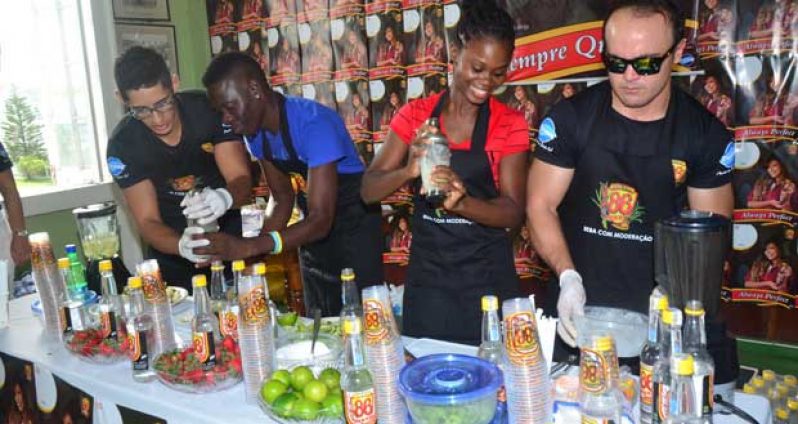SALTO Trading, the sole distributor of Brazilian Cachaça 86, a type of alcohol being widely used to make a Brazil cocktail called caipirinha, hosted a bartenders’ training course at Georgetown Cricket Club (GCC) on Monday. It was attended by 45 persons from bars across Guyana, where Cachaça went on sale from yesterday. At the event Mr. Pirima (only name given) owner of Cachaça 86 Boa Vista, explained, through an interpreter that the drink is a distilled spirit made from sugarcane juice.
Also known as aguardente, pinga, caninha and other names, it is the most popular distilled alcoholic beverage in Brazil and elsewhere cachaça is used almost exclusively as an ingredient in tropical drinks, with the caipirinha being a famous cocktail.
He related, further, that the distillation process dates back to 1532, when one of the Portuguese colonisers took the first cuttings of sugarcane to Brazil from Madeira. Cachaça is mostly produced in Brazil, where, according to

2007 figures, 1.5 billion litres (390 million gallons) are consumed annually, compared to 15 million litres (4.0 million gallons) outside the country.
It is typically between 38 percent and 48 percent alcohol by volume. When it is homemade, it can be as strong as the distiller wants.
“The Cachaça 86 that will be sold in Guyana is 40 percent alcohol,” he stated.
General Manager of Salto Trading, Mr. Jonathan Yearwood said his company is importing the Cachaça 86 directly from the manufactures and will market it in Guyana.
“We decided to host the training on how to use the Cachaça 86 in cocktails because we do not want to have it on the market and persons don’t know how to use it and then it becomes a flop. There are about 45 participants here today from a number of establishments that have indicated their interest in purchasing the Cachaça 86 and we are willing to train them for free,” he said.
Brazilian bartenders Lucas and John, through their translator, told the course participants of the techniques in making the caipirinha, where lime, white sugar, Cachaça 86 and ice is used to make this simple but tasty cocktail. Different fruits or flavours, such as pine, guava and ginger among others, can be added to ‘spruce up’ the cocktail which is then called ‘caipafruit’.
Cachaça is probably the antithesis of vodka, where you can be sure that any recipe has been tried, tested, sold by the bucket load and then reinvented time and again. It is uncharted, unexplored and is there for invention, this time without the stereotypes, they said.
(By Rebecca Ganesh-Ally)



.jpg)








